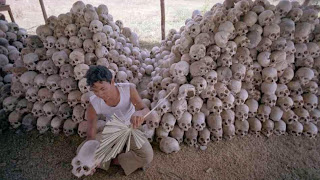 |
| Khmer Rouge soldiers at Angkor Wat. |
Nearly a quarter of Cambodia's population at least
1.7 million people died under
1975-1979 from execution, starvation, diseases and overwork by Khmer Rouge regime, according to the Documentation Center of Cambodia.
During their four years in power, Khmer Rouge overworked and starved the population, at the same time executing selected groups who they believed were the enemies of the state or spies or had the potential undermine the new state. People who they perceive as intellectuals or even those who had stereotypical signs or leaning, such as glasses, would also be killed. People would also be executed for attempting to escape from the commune or for breaching minor rules. If caught, offenders were taken quietly off to a distant forest or field after sunset and killed.
During this time, everyone was deprived of their basic rights. People were not allowed to go outside of their cooperative. The regime didn't allow anyone to gather and hold discussion. If three people gathered and talked, they could be accused of being enemies and arrested or executed.
 |
| People were forcing by Khmer Rouge to work |
All religions were banned by Khmer Rouge. Anyone seen taking part of religious rituals or services would be executed. Several thousands Buddhists, Muslims and Christians were killed for exercising their beliefs. Married couples were only allowed to visit each other on a limited basis. If people were seen being engage in sexual activity, they would be killed immediately. Almost all freedom to travel was abolished. People were not allowed to eat in privacy, they required to eat with everyone in the commune instead. All personal utensils were banned, they were given only one spoon and a bowl to eat with. All postal and telephone services were abolished.
Vietnamese troops fought their way into Cambodia in
December 1978. They captured Phnome Penh on
January 7, 1979. The leaders of the Khmer Rouge then fled their to the west of Cambodia and reestablished their forces.
The Khmer Rouge continued to exist until
1999 when all of it's leaders had defected to the Royal Government of Cambodia, been arrested or had died but their legacy remain.
Millions of mines were laid by the Khmer Rouge and Government forces, which have led to thousands of deaths and disabilities since
1980s. The large proportion of the Cambodian people have mental problem because their family members were lost and their spirits damaged. These factors are the major causes of the poverty that plagues Cambodia today.


